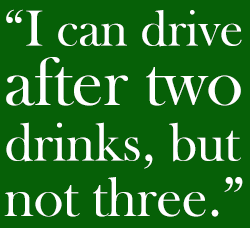If social drinkers measure their alcohol intake, it’s almost invariably in units of one drink. And that’s not a bad way to keep track, as long as nothing much is at stake.
A drink, in the US, comprises roughly 14 grams of alcohol – a measurement no one uses outside of government agencies. That amount of alcohol will be found in:
- A 12-ounce can or bottle of beer
- A 5-ounce glass of wine
- A 1.5 ounce shot of spirits
 Why do we care? The only time that measuring alcohol intake matters is when the effects of alcohol matter. And one place it really matters is behind the wheel.
Why do we care? The only time that measuring alcohol intake matters is when the effects of alcohol matter. And one place it really matters is behind the wheel.
Not everyone reacts to alcohol in the same way. We all know how some people can drink other people under the table. One’s resistance or susceptibility to alcohol – in other words, one’s drinking limit – depends on a number of factors:
- Age
- Sex
- Size and physical condition
- Fullness of stomach
- How fast the alcohol is consumed
 There are other factors too, but the upshot is that no two people react to alcohol the same way. If a 25 year-old man and a 65-year-old woman each had three drinks, their evenings might shape up quite differently.
There are other factors too, but the upshot is that no two people react to alcohol the same way. If a 25 year-old man and a 65-year-old woman each had three drinks, their evenings might shape up quite differently.
This unpredictability makes it dangerous to ply guests with even one drink if they intend to drive. Alcohol might have a much stronger effect on them than anyone expected. Just because you feel all right an hour after one drink doesn’t mean that everyone is able to drive under those circumstances.
The safest course of action is not to drink and drive, and to have a designated driver or a ride ready for a guest who needs it. It’s also advisable to know how much alcohol you can consume safely, and to remember that not everyone shares the same limit. Drinking reactions, like drinking preferences, are individual.
